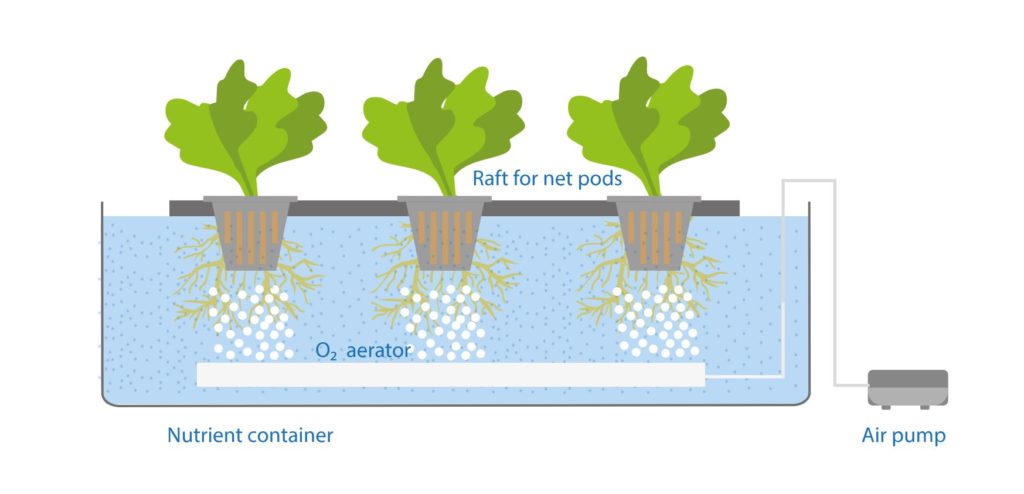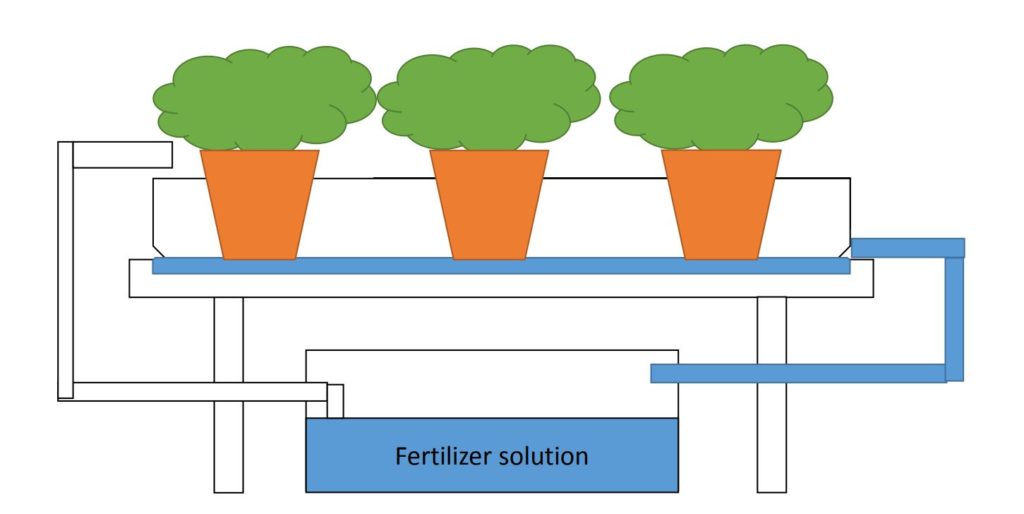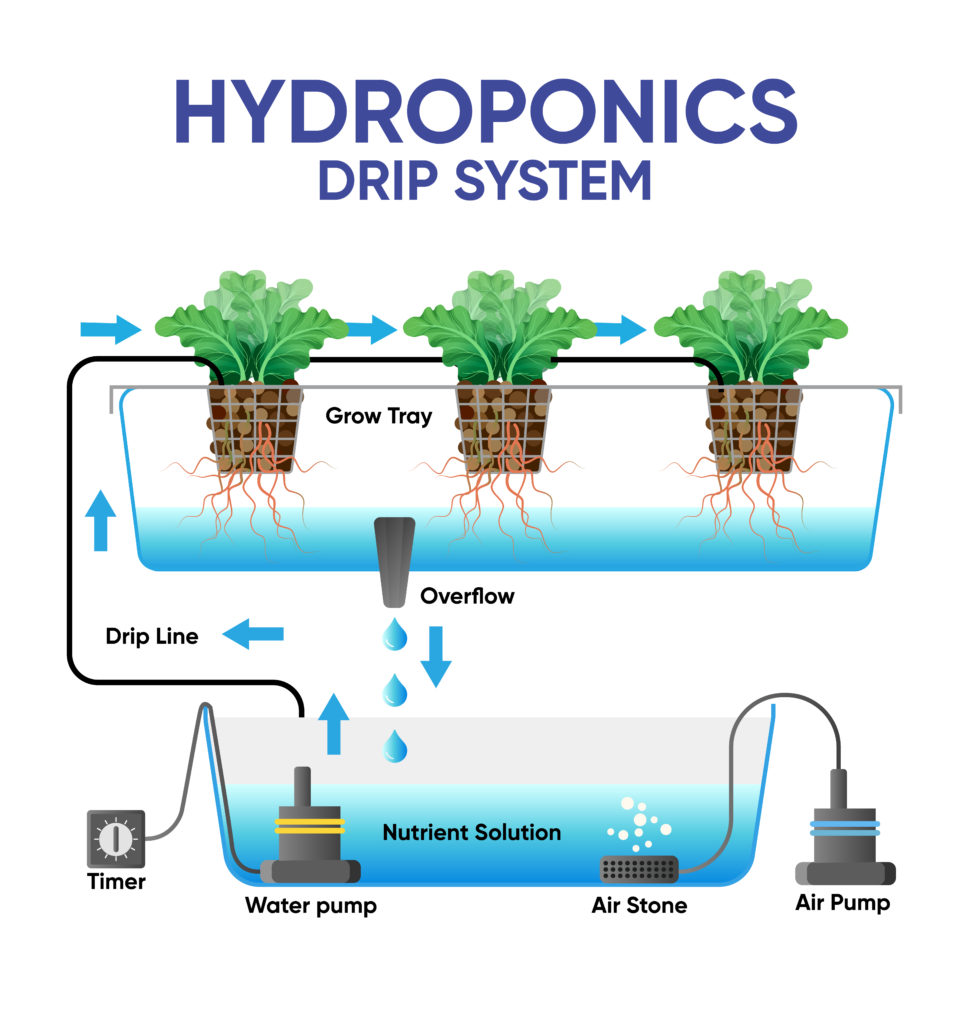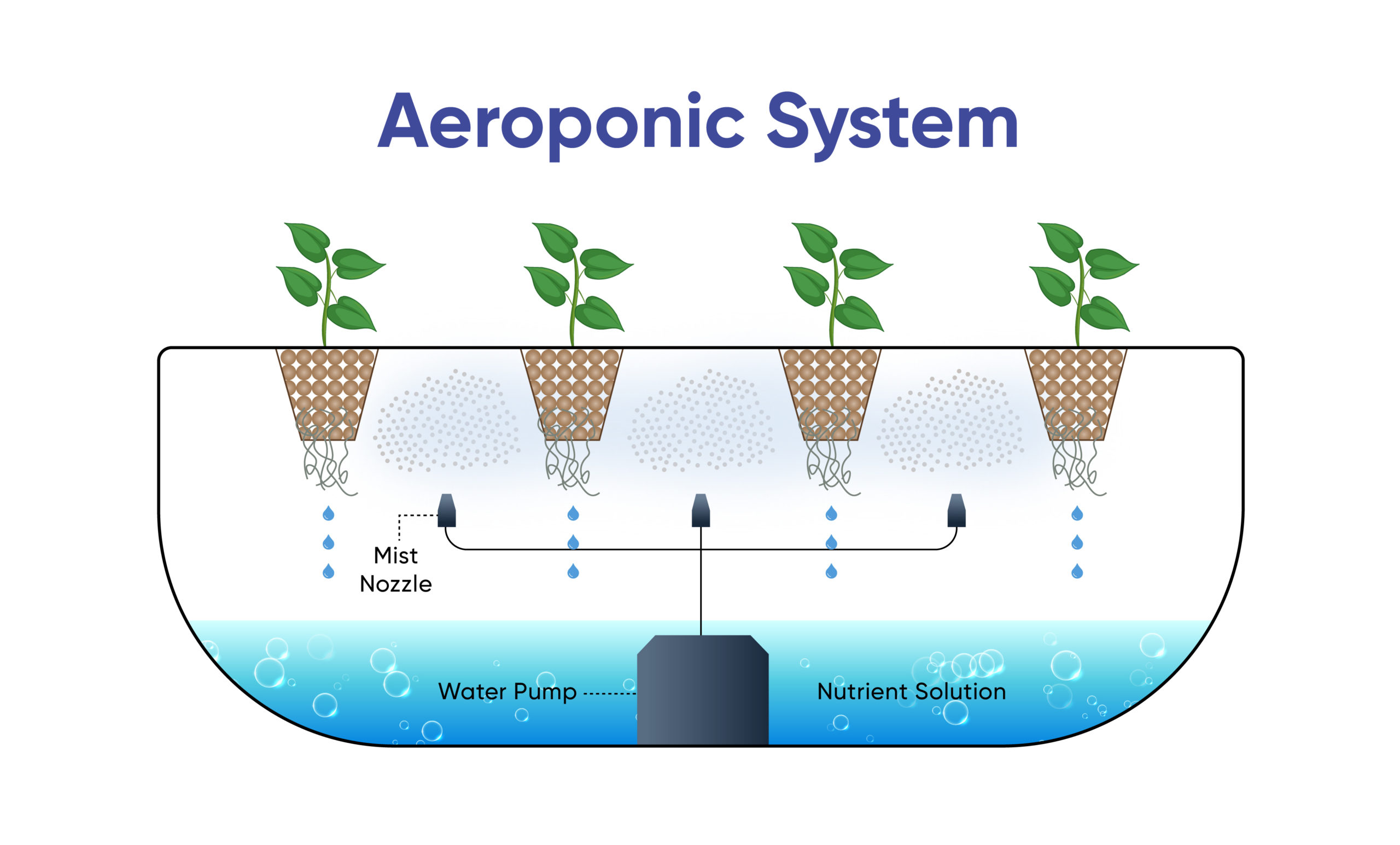There are 6 types of hydroponic systems that every hydroponic hobbyist should know about: the wick system, deep water culture (DWC), ebb and flow, nutrient film technique (NFT), the drip system, and aeroponics.
And regardless of variation or system complexity, each type has its own unique advantages and can be sourced from household items and local materials.
So, whether you’re an experienced hobbyist or a first-time grower, read this guide, explore each system, and pick the one that’s right for you! After all, you might find one that’s perfect for your growing needs!
If you’re new to hydroponics and would like to learn more, try reading our “What is Hydroponics” guide or try exploring our Hydroponics Hobby Center for all the latest and greatest information!
Table of Contents:
- The Wick System
- Deep Water Culture (DWC)
- Ebb and Flow (Flood and Drain)
- Nutrient Film Technique (NFT)
- Drip System
- Aeroponics
1. Wick System
Of all the hydroponic systems, the wick system is the easiest. It has no moving parts and requires zero electricity. Additionally, because of its simplicity, it can be built in a matter of minutes once you’ve gathered all the materials.
How It Works: The wick system is pretty straightforward and easy to understand. As pictured below, it uses a wick to bring nutrient-rich water up to your plants through something called “capillary action.” This basically means that the wick, which has one end in your reservoir and one end in your grow media, absorbs water within your reservoir and then slowly (like a sponge) transports nutrient-rich water up to your plant’s roots.
Wick systems are considered “passive hydroponics” because moving parts aren’t part of the system, however, if you’d like to add a pump, it will certainly help your roots receive more oxygen.

- Difficulty: Easiest type of hydroponic system
- Level of Expertise: No specialized experience needed
- Effectiveness: Not the most effective type of hydroponic system
- Affordability: Very affordable and easy to source
- Maintenance Level: Very little maintenance required (hands-off in most cases)
- Space Needed: Minimal space needed to set up and grow
Advantages
- Extremely easy and beginner-friendly
- Easy to build and construct
- Doesn’t require electricity or have moving parts
- Little maintenance required
- Great for small herbs
- Inexpensive and affordable
Disadvantages
- Doesn’t deliver nutrients at a high level (at least comparatively)
- Limited on what you can grow; will not do well with nutrient-hungry plants such as tomatoes
- Wicks can cause a toxic buildup of nutrients in the growing medium
Materials You Need to Get Started
- Plant Container (Small bin, Tupperware container, cookie jar, etc.)
- A wick (mop strand, tiki torch wicks, shoelaces, strips of cotton fabric, etc.)
- Nutrient Solutions (General Hydroponics Flora Series, FoxFarm Liquid Nutrient Formula, etc.)
- Reservoir (5-gallon bucket, plastic bin, etc.)
- Growing Medium (coco coir, perlite, vermiculite)
2. Deep Water Culture (DWC)
Deep Water Culture systems (sometimes referred to as just “water culture”) are easy, affordable, and effective. Used by hobbyists and commercial growers alike, DWC systems are extremely popular in the hydroponics world and continue to be the number one go-to for hobbyists.
How It Works: Deep Water Culture systems usually have three primary components: a reservoir, an air pump, and a net pot. Typically, or at least what you’ll see most often in hobby setups, your plants will sit on top of a reservoir (think of lettuce sitting on top of a 5-gallon bucket) and dangle their roots into nutrient-rich water below. And your roots, which are completely submerged, will receive oxygen by use of an air stone.
For an in-depth analysis, check out our “DWC Growing Guide” to learn more!

- Difficulty: Very easy for beginners and hobbyists
- Level of Expertise: No specialized experience needed
- Effectiveness: Very effective and can grow almost anything
- Affordability: Affordable and can be built with household items
- Maintenance Level: Some maintenance required (such as periodically changing the water)
- Space Needed: Minimal space needed for small setups (such as a single bucket)
Advantages
- Can be used for small-scale operations and large-scale operations
- Is very affordable and inexpensive to maintain
- Very little maintenance is needed once set up
Disadvantages
- Very difficult to grow rooting vegetables
- Can be difficult to keep the roots from drowning for first-timers
- Requires constant power/electricity to aerate roots
Materials You Need to Get Started
- Reservoir/Container (Small bin, Large Tupperware container, 5-gallon bucket, etc.)
- Air Pump with air hose and air stone (aquarium air pumps work great)
- Something to hold the plant in place (Net Pots, Styrofoam, etc.)
- Growing media for the plants (Hydroclay pellets, Coco Coir, etc.)
3. Ebb and Flow (Flood and Drain)
Ebb and Flow hydroponics (also referred to as “Flood and Drain” hydroponics) is another popular system used by hobbyists. As one of the more basic systems, ebb and flow systems are simple, inexpensive, and easy to set up. Additionally, you can grow just about anything (even rooting vegetables).
How It Works: Ebb and Flow hydroponics is fairly simple and involves the periodic flooding (e.g., every 30 minutes) of a “grow tray” or “media bed” where your plants sit. In the simplest of terms, water and nutrient solutions are pumped from a reservoir up to your growing area using a pump and timer. Then, as the water starts to rise and “flood” your grow tray (or whatever you’re using for a grow area), it reaches an overflow tube where it briefly soaks your plant’s roots and then trickles back down into your reservoir.
This gives your plant’s roots the perfect amount of (1) nutrient-rich water, and (2) oxygen as your roots will be exposed to both at separate times.
For a more in-depth explanation, try reading our “Ebb and Flow Hydroponics Guide.”

- Difficulty: Fairly easy for beginners but more difficult than DWC or Wick systems
- Level of Expertise: Intermediate experience needed
- Effectiveness: Very effective form of hydroponics
- Affordability: One of the more affordable options
- Maintenance Level: Some maintenance (Requires more maintenance than DWC)
- Space Needed: Some space needed — largely depends on size of setup
Advantages
- Multiple ways to design and implement ebb and flow hydroponics (flooding tray, Containers in a series, Dutch Bucket, overflow tube height system, combination of designs, etc.)
- Inexpensive system that can be sourced with household items
- Good for indoors and outdoors
- Can grow rooting vegetables such as carrots
Disadvantages
- May take some trial and error to get the system functioning correctly
- While maintenance is easy, you will be required to clean the system on occasion
- Some growing mediums are at risk of clogging the outlets and pumps
- System failure can flood your room or grow space (uncommon of course but has happened)
Materials You Need to Get Started
- A grow tray/container for the plants (might be best to build your own)
- A container to hold your water and nutrient solutions
- A submersible water pump that includes hosing (pond pumps do well)
- A timer to turn the pump on and off (such as the BN-LINK Digital Timer)
- PVC or other tubing to run water from the grow area back down to your reservoir
- Growing medium (Hydroton Expanded Clay Pebbles will work great for media beds)
- An overflow tube (PVC will work fine)
4. Nutrient Film Technique (NFT)
The Nutrient Film Technique (NFT) system is one of the more advanced hydroponic systems. So if you’re a beginner, it’s probably best to avoid this until you’ve got some experience under your belt. But, if you’re up for a challenge and want to give it a shot, then by all means give it a go.
How It Works: Similar to other hydroponic systems, the Nutrient Film Technique (NFT) system uses a pump and timer to push nutrient-rich water up to your growing area where it soaks your plant’s roots and then returns the water to your reservoir. The difference, however, is that with NFT systems, the water gets pushed to the highest part of your system, and then uses gravity to slowly trickle a “film” of water down a “shoot” “channel” or “tube,” where the water skims the bottom of the plant’s roots, providing your plants with just the right amount of nutrients, air, and water.
Read our “Nutrient Film Technique Guide” to learn more!

- Difficulty: Can be difficult to set up correctly
- Level of Expertise: For intermediate to advanced growers
- Effectiveness: Effective but best for quick-growing plants such as lettuce
- Affordability: Affordable but not as affordable as DWC and Ebb and Flow (see above)
- Maintenance Level: General maintenance is required to keep the flow steady and unobstructed
- Space Needed: Great for small spaces as you can vertically stack channels
Advantages
- The best way to grow hydroponic plants vertically
- Growing media is less of a concern and only used in net pots if needed
- Continual flow of recirculating water prevents salt buildup
- Easy to observe root quality
Disadvantages
- NFT systems may not work well for slow-growing plants
- Slope of channel needs to be correct (read our NFT guide to learn more)
- Plants with large root systems (such as tomatoes) can clog and prevent water flow
- Lots of moving parts that need to be maintained
- More expensive to set up than other hydroponic systems (DWC, Ebb and Flow)
Materials You Need to Get Started
- A channel, shoot, or tube to hold your plants (PVC, gutter downspouts, etc.)
- Net Pots or something similar to hold your plants in the tube
- Container/reservoir for your water and nutrient solutions
- Timer, submersible pump, and tubing to push water up to your channel
- Return system to drain the water back into your reservoir (PVC is easiest)
- Air pump and air stone (optional – only need to use if roots are completely submerged)
5. Drip System
The drip system is very popular in the hydroponics community and will work great for both hobbyists and commercial growers alike. And while the system mimics field-based agriculture and traditional farming, it is by no means the same thing.
How It Works: The concept of the drip system is pretty straightforward and exactly how it sounds. In essence, it’s taking nutrient-rich water, pushing it up to your grow area, and then slowly “dripping” it on your plant’s roots. The water, having soaked your growing media and your plant’s roots, will then either (1) recirculate and return to your reservoir (called a recovery drip system) or (2) not recirculate and stay where it is (called a non-recovery drip system).
Make sure to read our “Hydroponics Drip System Guide” for a more in-depth description!

- Difficulty: Somewhat difficult (getting the drip right can be tough)
- Level of Expertise: For intermediate to advanced growers
- Effectiveness: Effective and great for larger plants with big root systems
- Affordability: Home setups are just as affordable as Ebb and Flow and NFT systems
- Maintenance Level: General maintenance is required to keep the drip right
- Space Needed: Largely depends on the number of drip lines/plants you’re using
Advantages
- Multiple ways to design and implement
- Great for larger plants with big root systems
- Have the option to recirculate or not recirculate water
- Affordable option and can source parts locally
Disadvantages
- Non-recovery options can potentially waste water
- Can become complex when trying to expand system
- Getting the drip right takes some trial and error
Materials You Need to Get Started
- Some sort of container for the plants and roots (5-gallon bucket, etc.)
- A reservoir to hold your water and nutrient solutions
- A submersible pump (regular pond pump should do the trick)
- A timer for the pump (such as the BN-LINK Digital Timer)
- Tubing for the water lines and tubing for the return (plastic tubing, PVC)
- Growing media for the plants to sit in (coco coir, clay pellets, etc.)
6. Aeroponics
Out of the 6 types of hydroponic systems, aeroponics is the most effective. The downside, however, is that because it has a lot of moving parts, it isn’t exactly easy for first-time growers and hobbyists to master.
How It Works: Aeroponics is a system that truly focuses on the roots. In most designs, plant roots dangle into an enclosed chamber where they are “misted” with small droplets of nutrient-rich water. This exposes your plant’s roots to additional oxygen, allowing the plants themselves to grow bigger, faster, and healthier.
For an in-depth description, try reading our “What is Aeroponics” guide to learn more. Or, if you’re interested in building your own aeroponics system, feel free to explore our “DIY Aeroponics Guide.”

- Difficulty: The most difficult of the 6 types of hydroponic systems
- Level of Expertise: For advanced growers and hobbyists
- Effectiveness: The most effective hydroponic system (due to root oxygenation)
- Affordability: More expensive than the other hydroponic systems
- Maintenance Level: Regular maintenance is needed to ensure everything is working
- Space Needed: Great for limited space if using a tower setup
Advantages
- The most effective type of hydroponic system
- Great for vertical growing (especially if using vertical aeroponic towers)
- Roots are exposed to more oxygen
- Plants will grow faster
- Uses less water due to an enclosed chamber
- Harvesting is generally easier
Disadvantages
- More expensive to build and set up for hobbyists
- Mister heads and sprinklers can become clogged from mineral buildup
- Plants’ roots are susceptible to drying out if the chamber is not getting moisture
- Algae can easily accumulate where the plant meets the system (if light gets in)
- The smaller the droplet/mist, the harder it is to get the nutrients right
Materials You Need to Get Started
- Container or reservoir to hold your water and nutrients
- Submersible pump with tubing to distribute water
- Some sort of enclosed growing chamber for the roots and mist
- Mister and/or sprinkler heads to mist the roots (Acuteye misters work well)
- Timer to periodically release the water
Honorable Mention: The Kratky Method
While we won’t go into a lot of detail here, the Kratky Method is a subset of Deep Water Culture (DWC) where your plant’s roots are entirely submerged inside of a container (just like DWC). The main difference with Kratky, however, is that instead of adding nutrients in every couple weeks or so, all of the nutrients are added in at the very beginning of the growth cycle, and then never adjusted again. Thus, the Kratky Method has come to be called “set and forget” hydroponics!
If you’d like to learn more about the Kratky Method, make sure to check out our “Kratky Method Guide.”






